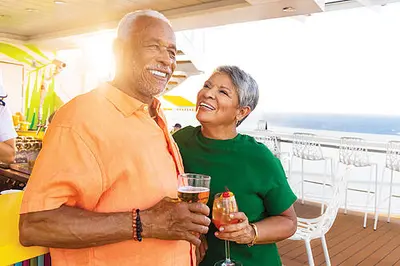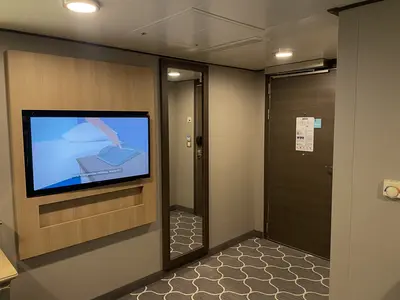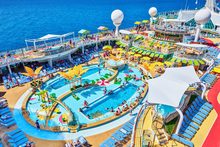Cruising isn’t just for the young and spry.

Cruise ships feature an experience that can be tailored to your preferences and needs.
This applies to everyone, including seniors and people who use mobility devices such as wheelchairs or scooters.
No matter your age and needs, you deserve a vacation filled with relaxation, excitement, and unforgettable memories.

Ken Klingenberg has been cruising for the past 23 years and has no intention of stopping.
A 72-year-old retired paramedic, he originally hails from Pittsburgh, Pennsylvania.
Ken won his first cruise in 1987 as part of a sales contest. That planted a seed that finally blossomed in 2001 when he and his wife sailed on their next cruise.
From then on, he has been hooked on cruising.

Since then, he has been on 41 sailings on Carnival, NCL, MVS, Celebrity, and Princess, with the majority—a total of 33—on Royal Caribbean.
Ken uses a scooter and says cruising is a great form of accessible travel.
“You get to this beautiful hotel on the water, and let the crew take you to different places while they feed and entertain you the entire time.”
He calls cruising a “godsend” for people with mobility or other issues.
Despite the overall accessibility of cruising, there are still limitations as part of traveling with a scooter

Ken has encountered fellow passengers rudely charging elevators or walking in front of him.
Ships also have narrow doorways or can lack ramp access to features he’s interested in.
Overly helpful people—cruisers as well as crew members—even reach out and grab the scooter or Ken himself.
With the insight from these stressful experiences, Ken has some valuable tips to make for a smoother journey.
Here’s his advice for fellow seniors who want to go on a cruise, whether or not they bring along a scooter or wheelchair.
When it comes to choosing the right cruise line, Royal Caribbean is one of the best

Selecting the right cruise line makes all the difference in your experience.
Not all lines are created equal, and if you’re looking for a line to cruise on with a scooter or wheelchair, you’ll want to be sure the ship will be accessible.
“One of the reasons I love cruising with Royal Caribbean is their commitment to those of us with mobility devices,” Ken says. “The other lines I have sailed have let me down to some extent.”

His issues center around the use (or lack) of ramps on ships. In his opinion, Royal Caribbean does the best at designing ships that include a lot of ramps.
Royal Caribbean also provides other great accommodations, like a chair lift in the Aqua Theater on Oasis Class ships, and a private elevator on the decks between the Seaplex and Two70 on Quantum Class ships.

Pools are harder to get to but usually have at least one with a chair lift available. However, “the issue is finding someone to operate them.”
As long as crew members are present to operate the lifts and elevators, Royal Caribbean does a great job ensuring that senior cruisers have full access onboard.
Although some areas have no access for someone in a wheelchair or scooter, Ken is usually able to access 99% of Royal Caribbean’s ships through ramps, elevators, or lifts.
Use a travel agent, especially one familiar with accessible travel

Ken advises that other seniors use travel insurance and a travel advisor for their cruises.
Buying travel insurance can help reimburse you for the cost of expensive equipment damaged while traveling, or help you provide for other necessities in the case of a delay.
Many travel insurance policies also add emergency medical reimbursement, a great reassurance for seniors worried about their health.

Using a travel agent can help take some of the stress out of cruising. Good travel agents come at no extra cost to you and can provide their expertise and knowledge to help you get the best experience possible with no extra costs.
Especially important would be finding a travel agent familiar with accessible travel, or who can put the client in touch with someone more familiar.
Ken consults with advisors from eCruisenet.com, longtime friends of his who weren’t well-versed in accessible travel at first but are becoming more in tune with it the longer they work together.
Using a small or folding scooter helps with getting through cabin doorways

What kind of cabin do you need to book if you’re bringing along a scooter or wheelchair?
The answer depends on the size of your mobility aid.
Smaller scooters may fit through standard cabin doorways, while larger models require the extra space provided in accessible cabins.
Standard stateroom doorways span at least 23 inches wide, while accessible staterooms have wide doors at least 32 inches wide.

Since Ken doesn’t need his scooter when inside the cabin, he purchased a folding scooter so that he can stay in a non-accessible stateroom.
“To make accessible cabins available to those who really need them, I made a conscious decision to find a scooter that would help me to that end,” he says.
Accessible cabins are few and far between on cruise ships.
For example, the new Icon of the Seas has 2,805 staterooms overall, 50 of which are accessible cabins in 10 separate categories.

That means that just over 1.7% of the staterooms on this brand-new cruise ship are designated as accessible.
“I would love to see the cruise lines build more accessible cabins,” Ken shares.
So if you're worried about being able to get assigned to an accessible cabin, bringing a smaller or a folding scooter is a smart choice.
Select a longer cruise to try everything onboard

Ken believes that “the ship is the destination.”
He recommends that fellow seniors pick and choose what activities they’d like to do and take advantage of the many food venues.
“You do not need to do everything the ship has to offer [but] there is no reason to go hungry.”

Cruise ships are loaded with onboard activities that cater to all interests and types. You can join trivia games, watch stunning shows, gamble at the casino, sunbathe by the pool, or join live dance lessons.
There’s something for everyone, no matter your level of activity.
Ken says that he tells everyone to try a 5 up to 7-Night cruise for their first cruise: “The 3 and 4-Night cruises tend to be ‘party boats.’”

Since you only unpack once—and cruises often have food, activities, and entertainment included in the cost—it makes sense to try everything possible and choose a longer cruise to take full advantage of the opportunities.
A cruise sailing has the perfect, relaxing accessible vacation for all ages, you just have to select the right cruise and activities.
Read more: Cruising over 60? Here are the top 10 reasons you should give it a try
Driving to your cruise port is easier than flying

When Ken first started cruising, he lived in Pittsburgh and preferred to drive to Bayonne or Baltimore for cruising.
This allowed him to not have to worry about any weight limits on baggage, ensuring he could bring his scooter and all necessary items in the car.

When getting onboard a cruise ship, there are very few weight restrictions, contrasting the strict rules for what you can carry onto a plane.
He also doesn’t have to worry about any damage to the scooter when driving.
Unfortunately, airlines are infamous for poorly treating people’s wheelchairs or scooters, and you’d never want such an expensive item damaged!
Look closely to find enjoyable excursions on port days

Exploring new destinations is a major highlight of cruising, so how can you find accommodating tours?
It’s not impossible, but you will have to plan ahead carefully.
The ship’s ramps allow for people with scooters or wheelchairs to exit and immediately access a local tourist area, usually full of restaurants, bars, and souvenir shops.
If you’re looking for actual excursions as well, many cruise lines do offer guided tours for seniors, such as short walking tours.

For example, Ken enjoyed touring the White Pass Railroad in Alaska.
He also likes to rent cabanas to sit in and relax, such as on Labadee and Perfect Day at CocoCay.
Read more: Comparing Royal Caribbean's Private Islands: CocoCay & Labadee
“But,” he adds, “I am most happy to watch others be happy.”







